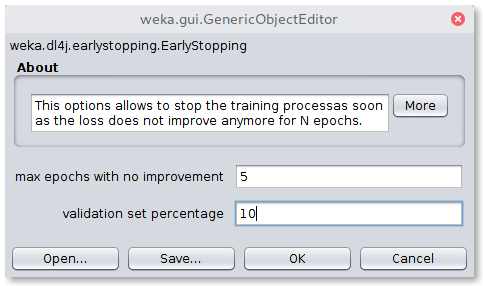Usage
If you are new to Weka, a good resource to get started is the Weka manual.
As most of Weka, the WekaDeeplearning4j's functionality is accessible in three ways:
- Via the commandline interface
- Programming with Weka in Java
- Using the Weka workbench GUI
All three ways are explained in the following. The main classifier exposed by this package is named Dl4jMlpClassifier.
Simple examples are given in the examples section for the Iris dataset and the MNIST dataset.
Make sure your WEKA_HOME environment variable is set.
GUI
The Dl4jMlpClassifier can be configured as shown below:
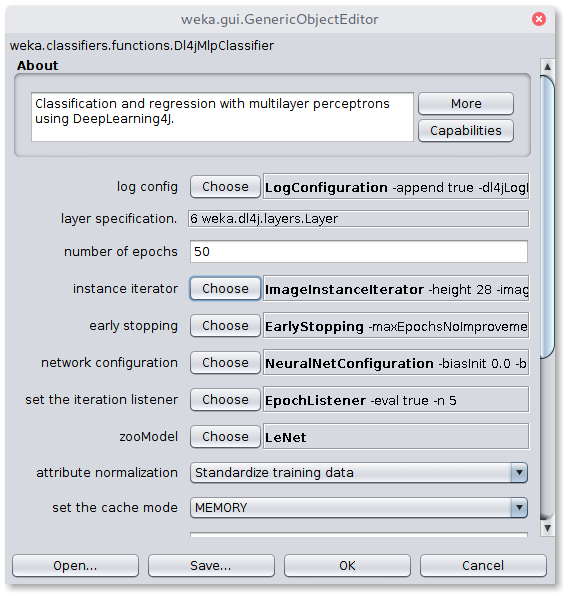
The network configuration option exposes further hyperparameter tuning:
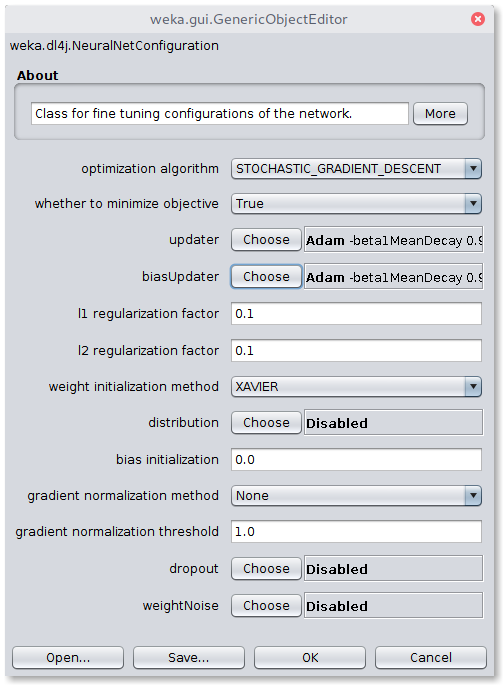
The layer specification option lets the user specify the sequence of layers that build the neural network architecture:
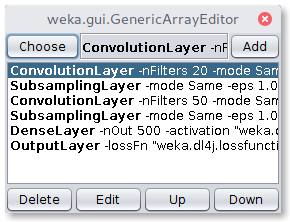
The user can choose from the following available layers:

A layer can be further configured, e.g. the ConvolutionLayer's options:
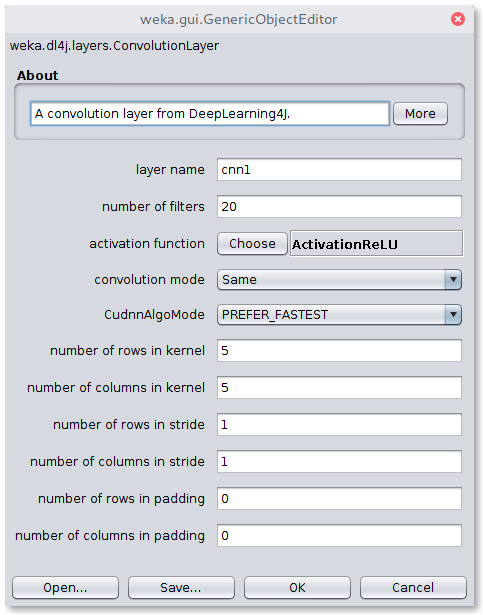
As explained further in the data section, depending on the dataset a certain InstanceIterator has to be loaded that handles parsing of certain data types (text/image). The iterator can be selected from the Dl4jMlpClassifier window via the instance iterator option. E.g. ImageInstanceIterator exposes the following options:
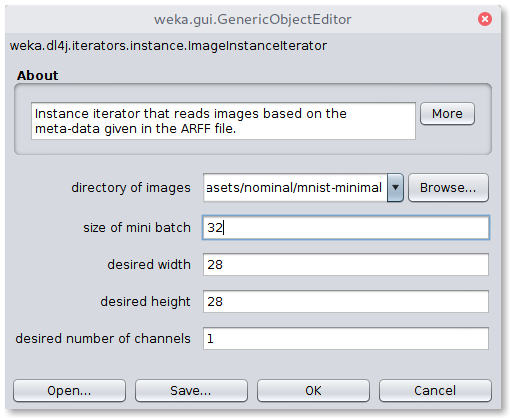
Commandline Interface
Assuming weka.jar is on the CLASSPATH, a first look for the available commandline options of the Dl4jMlpClassifier is shown with
$ java weka.Run .Dl4jMlpClassifier -h
Below the general options, the specific ones are listed:
Options specific to weka.classifiers.functions.Dl4jMlpClassifier:
-S <num>
Random number seed.
(default 1)
-logFile <string>
The name of the log file to write loss information to (default = no log file).
-layer <string>
The specification of a layer. This option can be used multiple times.
-numEpochs <int>
The number of epochs to perform.
-iterator <string>
The dataset iterator to use.
-config <string>
The neural network configuration to use.
-normalization <int>
The type of normalization to perform.
-queueSize <int>
The queue size for asynchronous data transfer (default: 0, synchronous transfer).
-output-debug-info
If set, classifier is run in debug mode and
may output additional info to the console
-do-not-check-capabilities
If set, classifier capabilities are not checked before classifier is built
(use with caution).
-num-decimal-places
The number of decimal places for the output of numbers in the model (default 2).
-batch-size
The desired batch size for batch prediction (default 100).
The most interesting option may be the -layer specification. This option can be used multiple times and defines the architecture of the network layer-wise.
$ java weka.Run \
.Dl4jMlpClassifier \
-layer ".DenseLayer \
-activation weka.dl4j.activations.ActivationReLU \
-nOut 10" \
-layer "weka.dl4j.layers.OutputLayer \
-activation weka.dl4j.activations.ActivationSoftmax \
-lossFn weka.dl4j.lossfunctions.LossMCXENT"
The above setup builds a network with one hidden layer, having 10 output units using the ReLU activation function, followed by an output layer with the softmax activation function, using a multi-class cross-entropy loss function (MCXENT) as optimization objective.
Another important option is the neural network configuration -conf in which you can setup hyperparameters for the network. Available options can be found in the Java documentation (the field commandLineParamSynopsis indicates the commandline parameter name for each available method).
Java
The Java API is a straight forward wrapper for the official DeepLearning4j API. Using the Dl4jMlPClassifier your code should usually start with
// Create a new Multi-Layer-Perceptron classifier
Dl4jMlpClassifier clf = new Dl4jMlpClassifier();
The networks architecture can be set up by creating each layer step by step:
DenseLayer denseLayer = new DenseLayer();
denseLayer.setNOut(10);
denseLayer.setActivationFunction(new ActivationReLU());
// Define the output layer
OutputLayer outputLayer = new OutputLayer();
outputLayer.setActivationFunction(new ActivationSoftmax());
Further configuration can be done by setting a NeuralNetConfiguration
NeuralNetConfiguration nnc = new NeuralNetConfiguration();
nnc.setUpdater(new Adam());
clf.setNeuralNetConfiguration(nnc);
Finally the layers are set with
// Add the layers to the classifier
clf.setLayers(denseLayer, outputLayer);
Without Maven
If you are not using the package in a maven project as described here, you need to add the following directories to your java classpath
$WEKA_HOME/packages/wekaDeeplearning4j/*$WEKA_HOME/packages/wekaDeeplearning4j/lib*
Assuming you have the following Main.java file:
import weka.classifiers.Evaluation;
import weka.classifiers.functions.Dl4jMlpClassifier;
import weka.core.Instances;
import java.io.FileReader;
import java.nio.file.Paths;
import java.util.Random;
public class Main {
public static void main(String[] args) throws Exception {
Dl4jMlpClassifier clf = new Dl4jMlpClassifier();
String irisPath = Paths.get(System.getenv("WEKA_HOME"), "packages", "wekaDeeplearning4j", "datasets", "nominal", "iris.arff").toString();
Instances inst = new Instances(new FileReader(irisPath));
inst.setClassIndex(inst.numAttributes() - 1);
Evaluation ev = new Evaluation(inst);
ev.crossValidateModel(clf, inst, 10, new Random(0));
System.out.println(ev.toSummaryString());
}
}
You can now compile it including the libraries in the classpath:
javac -cp "$WEKA_HOME/weka.jar:$WEKA_HOME/packages/wekaDeeplearning4j/*:$WEKA_HOME/packages/wekaDeeplearning4j/lib/*" Main.java
and run it with:
java -cp "$WEKA_HOME/weka.jar:$WEKA_HOME/packages/wekaDeeplearning4j/*:$WEKA_HOME/packages/wekaDeeplearning4j/lib/*:." Main
(Use ; as classpath separator for Windows instead)
Model Zoo
WekaDeeplearning4j now contains a wide range of pretrained image classification models. For more information, see the Model Zoo guide.
Early Stopping
Early stopping allows to stop the training process as soon as the network does not improve its loss on a validation set for N epochs.
The setup below adds an early stopping condition that checks whether the loss score on 10% of the training data did not improve successively for 5 epochs.
Commandline
-early-stopping "weka.dl4j.earlystopping.EarlyStopping -maxEpochsNoImprovement 5 -valPercentage 10"
Java
EarlyStopping es = new EarlyStopping();
es.setMaxEpochsNoImprovement(5);
es.setValidationSetPercentage(10);
clf.setEarlyStopping(es)
or simpler
clf.setEarlyStopping(new EarlyStopping(5, 10))
GUI
The GUI provides a simple and intuitive interface to configure the early stopping parameters:
